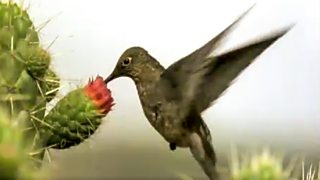
Landing craft
Every flight must end in a landing which takes skill to do safely. Big birds like pelicans have particular trouble. Swans are one of the heaviest flying birds so must land on the most forgiving of surfaces. On water they can use their feet as brakes. But albatross have to alight on the ground and are very clumsy, making their landings look more like controlled crashes. Most birds must come down with greater precision to land on a narrow ledge or thin branch. To do this, they have to lower their flaps, put down their undercarriage and brake hard to lose all air speed at the moment they come alongside their perch. A griffon vulture is able to exploit the position of its nest which is almost always on ledge of a cliff. It descends towards it at speed and aims for a point below its nest. It then swoops upwards, so that its forwards speed is zero as it arrives at the ledge. Landing into the wind helps birds to maintain lift until the last moment.
Duration:
This clip is from
Featured in...
![]()
麻豆约拍 Nature
Be captivated, informed and inspired by the world's wildlife.
More clips from The Mastery of Flight
-
![]()
Light fantastic
Duration: 01:48
-
![]()
Air display
Duration: 01:28
-
![]()
Stationary view
Duration: 01:19
-
![]()
Aerodynamic albatross
Duration: 01:59
More clips from The Life of Birds
-
![]()
Weka Territory—To Fly or Not to Fly?
Duration: 01:08
-
![]()
Feet on the ground—To Fly or Not to Fly?
Duration: 00:51
-
![]()
Thirst quencher—The Limits of Endurance
Duration: 03:10
-
![]()
Food on the run—Meat-Eaters
Duration: 02:12










